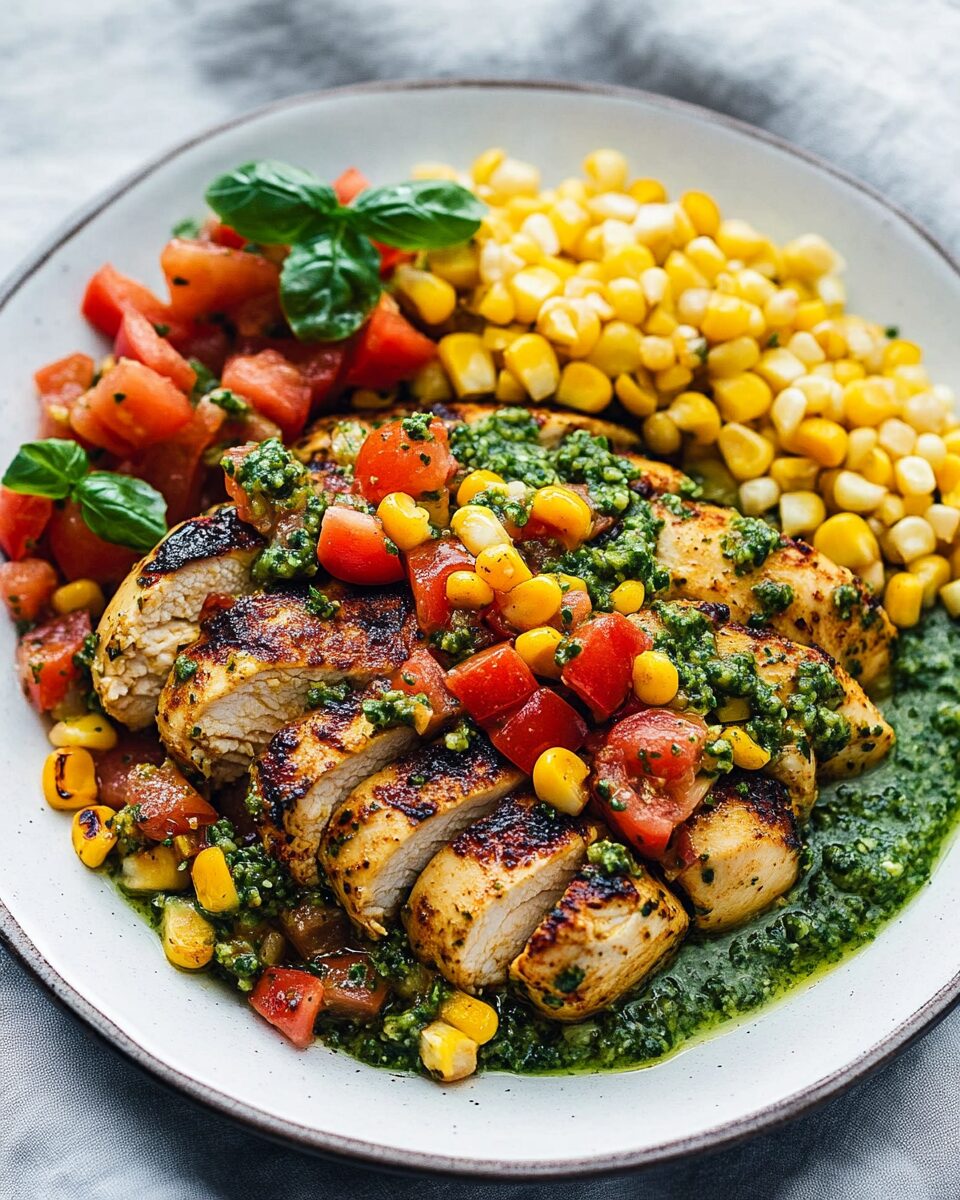Pesto chicken is a simple yet flavorful dish that combines tender chicken breasts with a vibrant, aromatic pesto sauce. This dish is perfect for a quick weeknight dinner or a more elegant meal. The pesto adds a fresh, herby touch to the chicken, making it a crowd-pleaser.
FULL RECIPE
Ingredients
- 4 boneless, skinless chicken breasts
- 1/4 cup pesto sauce (store-bought or homemade)
- 1 tablespoon olive oil
- Salt, to taste
- Freshly ground black pepper, to taste
- 1/2 cup grated Parmesan cheese
- Fresh basil leaves for garnish (optional)
Directions
- Preheat your oven to 375°F (190°C).
- Season the chicken breasts with salt and pepper on both sides.
- Heat olive oil in a large oven-safe skillet over medium heat.
- Once the skillet is hot, add the chicken breasts and cook for 3-4 minutes per side until golden brown.
- Remove the skillet from heat and spread a generous amount of pesto sauce over each chicken breast.
- Sprinkle Parmesan cheese on top of the pesto-coated chicken breasts.
- Transfer the skillet to the preheated oven and bake for 15-20 minutes, or until the chicken reaches an internal temperature of 165°F (74°C).
- Remove from the oven and let the chicken rest for a few minutes before serving.
- Garnish with fresh basil leaves, if desired, and serve immediately.
Nutrition Facts
- Calories: 300 kcal per serving
- Protein: 30g per serving
- Carbohydrates: 3g per serving
- Fat: 18g per serving
- Fiber: 1g per serving
Chicken as the Perfect Protein for Pesto
Chicken is a popular protein choice because of its mild flavor and versatility in various cooking methods. When paired with pesto, the subtle taste of the chicken allows the bold and vibrant flavors of the pesto to shine through. Boneless, skinless chicken breasts are commonly used for this dish because they cook quickly and remain tender, especially when baked or seared.
The Health Benefits of Pesto Chicken
Pesto chicken offers several health benefits. Chicken breasts are a lean source of protein, which is essential for muscle repair and growth. When paired with pesto, the dish also provides healthy fats from olive oil and nuts. Pesto typically includes olive oil, which is rich in monounsaturated fats, known to support heart health.
Choosing the Right Type of Pesto for Pesto Chicken
While traditional basil pesto is the most common type used for pesto chicken, there are many variations of pesto that can be experimented with. For instance, you can opt for a sun-dried tomato pesto, which offers a richer, tangier flavor. A spinach and walnut pesto can be a great choice for those looking to increase their intake of leafy greens and enjoy a slightly earthier flavor. The variety of pesto sauces available allows you to tailor the dish to your personal preferences or dietary needs, adding versatility to the recipe.
Cooking Methods for Pesto Chicken
While the recipe suggests baking the chicken, there are several other methods for preparing pesto chicken. Grilling the chicken can impart a smoky flavor that complements the freshness of the pesto, creating a delicious contrast. If you prefer a faster option, pan-searing the chicken in a skillet also works well, allowing the chicken to develop a golden crust before finishing it off with the pesto sauce. No matter the method, it’s essential to cook the chicken to the right internal temperature to ensure it remains tender and juicy.
The Role of Parmesan in Pesto Chicken
Parmesan cheese is an essential ingredient in pesto, adding a salty, nutty flavor to the sauce. When used on top of the chicken, the cheese melts beautifully into the pesto, enhancing the dish’s overall richness. Parmesan also acts as a binder for the pesto, helping the sauce adhere to the chicken. Whether freshly grated or pre-shredded, Parmesan brings depth to the flavor profile and complements the herbal notes of the basil.
How to Make Pesto Chicken Gluten-Free
For those following a gluten-free diet, pesto chicken is an excellent option. Both the chicken and pesto are naturally gluten-free, making the dish suitable for gluten-sensitive individuals. However, it’s important to check the pesto ingredients, as some store-bought versions may contain gluten or other additives. If preparing homemade pesto, ensure that all ingredients, such as Parmesan cheese and nuts, are certified gluten-free.
Pairing Pesto Chicken with Side Dishes
Pesto chicken is a versatile dish that pairs well with a variety of side dishes. A simple salad with mixed greens and a light vinaigrette can complement the richness of the chicken. For a more substantial meal, consider serving it with roasted vegetables, such as zucchini, bell peppers, and cherry tomatoes. If you’re looking for a starch, pasta, rice, or quinoa can be served alongside the chicken, with a drizzle of extra pesto to tie the flavors together. The key is to choose sides that balance the boldness of the pesto without overpowering the chicken.
Serving Suggestions for Pesto Chicken
Pesto chicken can be served in various ways to suit different occasions. For a casual weeknight dinner, serve the chicken with roasted vegetables and a simple salad. For a more formal meal, slice the chicken and serve it atop a bed of pasta, garnished with fresh basil and extra Parmesan. If you’re hosting a dinner party, consider serving the chicken with an appetizer like bruschetta or a cheese board, followed by a light dessert such as lemon sorbet. The presentation of the dish can also be enhanced by arranging the chicken neatly on a platter and drizzling the pesto over the top just before serving.
How to Store Leftover Pesto Chicken
Leftover pesto chicken can be stored in an airtight container in the refrigerator for up to 3 days. To reheat, gently warm the chicken in the oven or microwave, being careful not to dry it out. If you prefer to keep the pesto fresh, you can store it separately and add it just before serving. For longer storage, pesto chicken can be frozen for up to 3 months. To reheat frozen pesto chicken, allow it to thaw in the refrigerator overnight before reheating.
Making Pesto Chicken for Meal Prep
Pesto chicken is an excellent choice for meal prepping. The chicken can be cooked in advance and stored in the refrigerator for several days, making it easy to assemble meals throughout the week. Pairing the chicken with a variety of vegetables or grains allows for a balanced, nutrient-dense meal that can be quickly reheated when needed. For those who prefer fresh pesto, it can be made in bulk and stored in the fridge for up to a week or frozen for longer storage.
Substituting Chicken for Other Proteins
While chicken is the most popular protein for this dish, pesto can be paired with other meats or plant-based proteins for variety. For instance, turkey breasts or thighs can be used in place of chicken for a leaner alternative. If you prefer red meat, pork chops or tenderloin can also work well with pesto. For a vegetarian option, tofu or tempeh can be marinated in pesto and then baked or grilled, offering a plant-based take on this dish.
Why Use Fresh Basil in Pesto Chicken
Fresh basil is key to the vibrant flavor of pesto. It contributes to the sauce’s aromatic qualities, providing a bright, slightly peppery taste that pairs perfectly with the richness of the chicken. While dried basil can be used in a pinch, fresh basil imparts a much stronger and fresher flavor. If you’re growing your own basil at home, it’s a great way to enhance your pesto chicken with homegrown ingredients that taste even better.
The Importance of Seasoning the Chicken
Before applying the pesto sauce, it’s crucial to properly season the chicken with salt and pepper. This step enhances the overall flavor of the dish, ensuring that the chicken is well-seasoned before the pesto is added. If the chicken isn’t seasoned enough, the pesto may not have the desired effect, and the dish could taste flat. Additionally, seasoning the chicken allows for a more flavorful crust when searing or roasting the chicken, improving both texture and taste.
Making Homemade Pesto for Pesto Chicken
While store-bought pesto is convenient, homemade pesto offers superior flavor and allows you to control the quality of ingredients. Making pesto at home is simple and requires just a few ingredients: fresh basil, garlic, pine nuts, Parmesan cheese, and olive oil. To make the pesto, blend the ingredients in a food processor until smooth, and adjust the seasoning to taste. Homemade pesto can also be customized to suit personal preferences, such as adding lemon juice for a bit of brightness or using different nuts like walnuts or cashews.
The Versatility of Pesto in Other Dishes
Pesto isn’t just for chicken—it’s a versatile ingredient that can be used in many other dishes. You can spread pesto on sandwiches, drizzle it over roasted vegetables, or stir it into pasta. It also makes an excellent topping for pizza or a flavorful dip for bread and crackers. The versatility of pesto makes it an ingredient worth keeping on hand in your kitchen, as it can elevate a wide variety of meals.
Pesto Chicken for Special Diets
Pesto chicken can be easily adapted for various dietary needs. For those following a low-carb or keto diet, the dish naturally fits the bill since it’s high in protein and healthy fats while being low in carbohydrates. For those on a dairy-free or vegan diet, pesto can be made without cheese or replaced with nutritional yeast. Substituting chicken with plant-based proteins, such as tofu or tempeh, makes this dish vegan-friendly while still maintaining the rich flavors of pesto.
How Pesto Chicken Fits Into a Mediterranean Diet
The Mediterranean diet emphasizes whole foods, healthy fats, and lean proteins, which makes pesto chicken a perfect fit. With its combination of chicken, olive oil, fresh herbs, and nuts, pesto chicken is in line with the principles of the Mediterranean diet. Incorporating dishes like pesto chicken into your weekly meals can help you follow a healthy, balanced diet rich in nutrients while still enjoying delicious, flavorful food.
The Impact of Pesto Chicken on a Balanced Meal
Pesto chicken is not only delicious but also well-rounded in terms of nutrition. The dish is high in protein, which supports muscle health, and the healthy fats from olive oil and nuts contribute to heart health. The addition of basil and other fresh ingredients also boosts the dish’s antioxidant content. When paired with vegetables or whole grains, pesto chicken offers a balanced, nutrient-dense meal that satisfies hunger without compromising on taste.
Conclusion
Pesto chicken is a flavorful and versatile dish that can easily be incorporated into various meal plans. Whether you’re looking for a quick dinner or a dish to impress guests, pesto chicken delivers both in taste and presentation. With its blend of tender chicken and vibrant pesto sauce, it offers a perfect balance of nutrition and flavor. By experimenting with different variations of pesto and side dishes, you can tailor the meal to suit your taste preferences and dietary needs.






